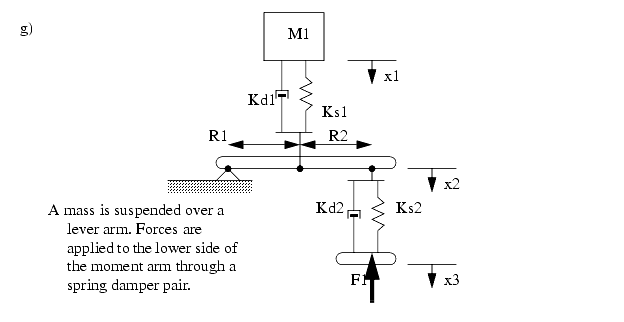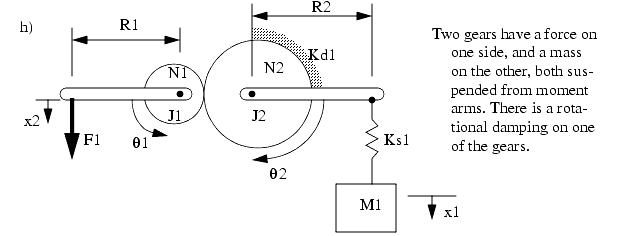14.3 PRACTICE PROBLEMS
1. a) Put the differential equations below in state variable form.
b) Put the state equations in matrix form

2. Find the input-output form for the following equations.

3. a) write the differential equations for the systems pictured below (assume small angular deflections).
b) put the equations in state variable form.








4. For the mechanism in the figure below,

a. Find the differential equations for the system. Consider the effects of gravity.
b. Put the equations in state variable form.
c. Put the equations in state variable matrices.
d. Use your calculator to find values for x1 and x2 over the first 10 seconds using 1/2 second intervals. Use the values, K1=K2=100N/m, B=10Nm/s, M1=M2=1Kg. Assume that the system starts at rest, and the springs are undeformed initially.
e. Use Mathcad to plot the values for the first 10 seconds.
f. Use working model to find the values for the first 10 seconds.
g. Use Mathcad and the Runge-Kutta calculations in the notes to find the first 10 seconds using half second intervals.
h. Repeat step g. using the first order approximation method.
5. You are given the following systems.

a) Draw FBDs and write the differential equations for the individual masses.
b) Combine the equations in input-output form with y as he output and F as the input.
c) Write the equations in state variable matrix form.
d) Use Runge-Kutta to find the system state after 1 second.
6. For the mechanism in the figure below,

a. Find the differential equations for the system.
b. Put the equations in state variable form.
c. Put the equations in state variable matrices.
d. Use your calculator to find values for x1 and x2 over the first 10 seconds using 1/2 second intervals. Use the values, Ks1=Ks2=100N/m, Kd1=10Nm/s, M1=M2=1Kg. Assume that the system starts at rest, and the springs are undeformed initially.
e. Use Mathcad to plot the values for the first 10 seconds.
f. Use working model to find the values for the first 10 seconds.
g. Use Mathcad and the Runge-Kutta calculations in the notes to find the first 10 seconds using half second intervals.
h. Repeat step g. using the first order approximation method.